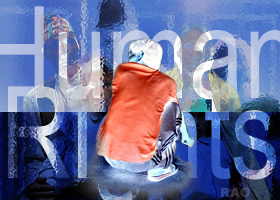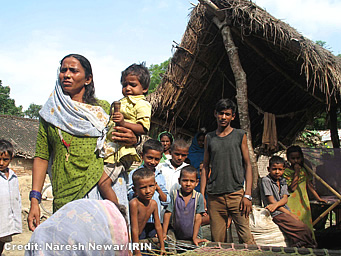|
Nepal
in Crisis 2006: Human Rights
|
|
The
conflict's dangerous impact on health services
|
 |
Kathmandu,
02 February 2006 (IRIN)
Rural
health services are negligible and the problem has worsened as a result
of the conflict.
| Bhojpur |
 |
 |
| The
three-day journey for 52-year-old Maniram Rai and his wife was almost too
much to bear. In agony with stomach pains and a high fever, Rai's condition
worsened after walking all the way from Lekharka village in the remote,
hilly Bhojpur district, to reach the Nepali city of Dharan. |
|
"This
is the reality in our village. We can't even get proper care, there are
no medicines or doctors," said Rai from his bed at the BP Koirala Hospital
in Dharan, where he has been gradually recovering after a week in intensive
care.
 |
| Although
Nepal's government claims that national healthcare has hardly been affected
by the nine year-old Maoist conflict, health workers, especially those
in vulnerable rural communities, tell a different story. They say that
the rebellion has had a major impact on the delivery of basic health provision
in many parts of the Himalayan kingdom.
Nepal
has always had a marginal health service - villagers have had to travel
to urban areas and towns for proper care for generations. The government
has registered some successes in recent years, including progress in combating
tuberculosis, leprosy, Vitamin A deficiency and measles. |
|
But
the bigger picture, particularly for rural Nepalis, is far less encouraging.
The conflict has left most government-run rural clinics - known as health
posts - short of medical supplies and skilled staff.
"The
health posts are there only in name. We have to take all the pain of travelling
to the cities," explained 65-year-old Jamandwoj Rai, who spent four days
getting to hospital in Dharan for treatment on a septic leg wound. "I"m
lucky that I had some money to travel here, but many of our poorest villagers
die at home," he added, explaining that his village had not seen a single
doctor or trained government health worker for more than a year.
"There
is definitely a negative impact on our health system because of the war,
especially due to the unwillingness of skilled health workers and doctors
to visit villages controlled by the Maoists," said Paras Pokhrel, a doctor
from Dharan"s community medicine programme.
Although
his unit has made efforts to send nurses and doctors into at least six
districts where the health situation is at its worst, most are very reluctant
to be based there, despite the fact that few health workers have actually
lost their lives in the conflict. "I am very afraid. There is no security
outside the main towns. I do want to help people in need, but I have my
own safety to consider," one nurse in Dharan explained.
According
to statements by Maoist leaders, health workers have never been targeted.
Despite this reassurance, many rural health staff point out that the government
has not offered such guarantees, and say they fear being caught-up in clashes
between the rebels and security forces.
Villagers
in many parts of the country have no choice but to rely on the network
of Female Community Health Volunteers, a well-meaning but untrained and
under-resourced corps of rural carers.
| Rukum |
 |
 |
Khalanga
airport, Rukum: Flights are often the only means of transport to reach
the cities from remote villages, but they are unreliable and frequently
cancelled. Only a few months ago in Rukum, a woman suffering from a pregnancy-related
problem who needed emergency treatment, died when the flight did not arrive.
|
|
 |
< The three-day journey for 52-year-old Maniram Rai and his wife was almost
too much to bear. In agony with stomach pains and a high fever, Rai's condition
worsened after walking all the way from Lekharka village in the remote,
hilly Bhojpur district, to reach the Nepali city of Dharan.
When
it comes to complications in pregnancy and childbirth, most volunteers
are out of their depth.
The
Ministry of Health has estimated that nearly 4,500 women die every year
from pregnancy-related complications, mostly due to lack of skilled birth
attendants and the absence of emergency services and equipment in rural
health centres. |
|
The
Maoists say they have established a health infrastructure in the rural
areas they control, but villagers in some rebel areas who spoke to IRIN
said this was largely propaganda and that there were very few clinics or
doctors organised by the insurgents.
It
is not just treatment facilities that have suffered, all-important health
education programmes have also stopped in many rural parts of Nepal. "The
indirect impact of the conflict is of more serious concern. Due to immense
psychological fear among health workers, health education and supervision
for preventive healthcare measures have been greatly reduced," said safe
motherhood expert Indira Basnet in Kathmandu.
In
a country with a very low literacy rate, awareness of basic health practices
-; like washing hands and disposing of human waste properly - is considered
of crucial importance in reducing the big killers: diarrhoea, malaria,
encephalitis and acute respiratory infections. According to the Ministry
of Health, diarrhoea kills about 30,000 children every year, and acute
respiratory diseases affected nearly a million children all over the country.
Massive
internal displacement and migration to Nepal's cities due to the war, have
also taken their toll on the population. A record number of children now
suffer from malnutrition. According to UNICEF, about 48 percent of children
under the age of five, suffer from being underweight.
"The
country's health services at village level have been pushed 10 years back,"
said Pokhrel, who added that the country's health indicators would further
deteriorate if the conflict continued.
Credit
IRIN 2006
Copyright
© UN Office for the Coordination of Humanitarian Affairs 2006
[
This report does not necessarily reflect the views of the United Nations]
Integrated
Regional Information Networks (IRIN), part of the UN Office for the Coordination
of Humanitarian Affairs (OCHA).
 |
 |
External
link |
|








